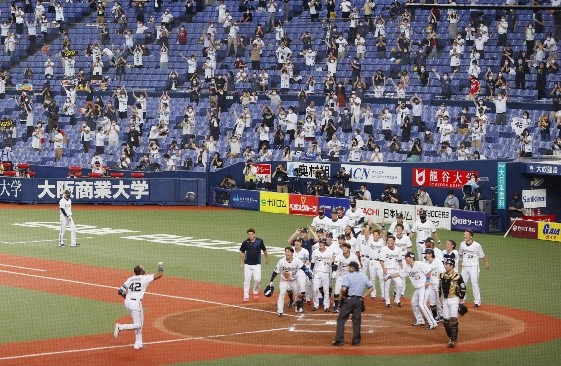NPB, J. League will ask Japan's government to relax attendance limits

• (The Japan Times Sep 7, 2020)
Nippon Professional Baseball and the J. League plan to submit a request to the government to relax limits on attendance at large events, with the spread of COVID-19 appearing to be slowing down within the nation, the two leagues announced Monday.
“We have heard the view of our medical panel that the infection rate has settled down nationwide,” said NPB Commissioner Atsushi Saito in an online news conference after the 15th meeting of the leagues’ joint task force.
“Right now, we are allowing up to 5,000 fans into stadiums, but we would like to think about the next steps,” he continued. “We’ve agreed with (J. League) Chairman (Mitsuru) Murai that we will present our request, to relax the limit, to the government as soon as tomorrow.”
The government is scheduled to hold its subcommittee meeting concerning the virus on Friday. The leagues hope their request will be discussed during that gathering.
One reason the leagues are looking to revise the existing guidelines is that a cap of 5,000 doesn’t account for the varying capacities and seating arrangements of the stadiums in each circuit.
The government states in its guidelines that organizers of large-scale events can either operate at half-capacity or with a maximum of 5,000 people inside.
Murai noted the differences in the number of people various venues can hold. For instance, Nissan Stadium, home to the Yokohama F. Marinos, can hold up to 70,000, while some venues in the second division have capacities of around 10,000. Murai said it’s time for the leagues to move to the next phase in order to evenly apply any limits on attendance while also recognizing each club’s individual situation.
“Our J. League has coped with the situation based on our guidelines, but I think that we can welcome (more) fans to the stadiums,” Murai said. “On a step-by-step basis, we are going to request relaxation of the rule. I think it’s part of our role as members of society as well.”
Considering the differences in stadium capacities, Saito said it would be better to set limits based on percentages rather than a hard and fast figure.
Saito and Murai were unclear about whether their leagues would include a suggested percentage or other figures in their request. They did say, however, that their leagues would continue to follow the guidelines set out by the government.
The task force’s medical panel is in agreement with the leagues’ push to allow more fans.
Mitsuo Kaku, an infectious disease specialist who leads the panel, said there had been no cluster infections under the current guidelines and that it was time for the government and the leagues to examine whether it’s appropriate to adjust the restrictions.
“You have to have social distancing, so it’s not possible to fill the stadiums,” Kaku said. “But based on the condition that you make sure you have social distancing and follow other measures for the virus, I think the number of people who can be allowed in, or a set percentage, should be calculated.”
The members of the task force also said the leagues could serve as a test case for measures that may be used for next summer’s Tokyo Olympics and Paralympics, which have been postponed due to the ongoing pandemic.
“I think that NPB and the J. League have become a model (for Japan) toward next year’s Olympics and Paralympics,” said Hiroshige Mikamo, another infectious disease expert on the panel. “I think it’s a fact that other sports organizations have run their leagues following what these two leagues have done.”
“We’re going to continue to add what needs to be added to the guidelines, and improve them,” Mikamo added. “And then I think the league operations will go more smoothly, and that will aid the Olympics and Paralympics.”



